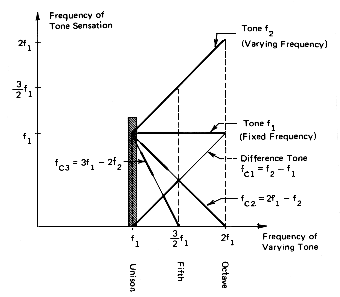When two TONEs are perceived simultaneously, other tones often appear, because of DISTORTION effects in the ear. These tones are said to have been discovered by the violinist Tartini around 1750. Relatively high intensity levels are required for combination tones to be heard, and strong differences exist between individuals as to how many are heard.
If two SINE TONEs are played at a sufficient intensity level, one high (x) and the other low (y), the combination tones usually heard are the DIFFERENCE TONEs, at frequencies equal to (x - y), (2y - x) and (3y - 2x). The SUMMATION TONEs of frequencies (x + y) and (2x + y) are seldom if ever heard, even when in the audible range, possibly because of MASKing effects.
The threshold of such tones varies greatly between individuals, since it depends on non-LINEAR characteristics of the INNER EAR, but generally it lies between 50 and 60 dB. BEATS, on the other hand, can be heard at low intensities.
Compare: AURAL HARMONICS, OVERTONE, PARTIAL, SIDEBAND.. See also: CRITICAL BANDWIDTH, HETERODYNE.

Frequencies of the combination tones fC1, fC2, fC3 evoked by a two-tone superposition of frequencies f1, f2. Heavy lines indicate the most easily detected ranges of the combination tones (from Roederer, Introduction to the Physics and Psychophysics of Music, Springer, 1975, p. 35, used by permission).
![]() Sound
Example: Two sine waves, one fixed at
500 Hz, the other ascending from 500 Hz to 1000 Hz, producing
aural combination tones when heard at a sufficient
loudness.
Sound
Example: Two sine waves, one fixed at
500 Hz, the other ascending from 500 Hz to 1000 Hz, producing
aural combination tones when heard at a sufficient
loudness.
home